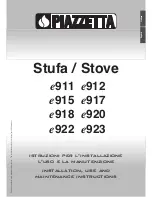
IMPORTANT WARNING
This stove must not be installed into a chimney that serves any other heating appliance.
There must not be an extractor fan fitted in the same room as the stove as this can cause the stove to emit fumes into the room.
Properly installed, operated and maintained this stove will not emit fumes into the dwelling. Occasional fumes from de ashing and re fuelling may
occur. However, persistent fume emission is potentially dangerous and must not be tolerated. If fume emission does persist, then the following
immediate action should be taken:
(a)
Open doors and windows to ventilate the room and then leave the premises.
(b)
Let the fire go out.
(c)
Check for flue or chimney blockage and clean if required.
(d)
Do not attempt to relight the fire until the cause of the fume emission has been identified and corrected.
If necessary seek expert advice.
The most common cause of fume emission is flueway or chimney blockage. For your own safety these must be kept clean at all times.
PREPARATORY WORK AND SAFETY CHECKS
Chimney
In order for the stove to perform satisfactorily the chimney height must
be sufficient to ensure an adequate draught of approximately 15 Pa so as
to clear the products of combustion and prevent smoke problems into the
room.
NOTE:
A chimney height of not less than 4.5 metres measured vertically
from the outlet of the stove to the top of the chimney should be
satisfactory. Alternatively the calculation procedure given in EN 13384-1
may be used as the basis for deciding whether a particular chimney design
will provide sufficient draught. BS EN 15287-1:2007 gives additional
details.
The outlet from the chimney should be above the roof of the building in
accordance with the provisions of Building Regulations Approved
Document J.
If installation is into an existing chimney then it must be sound and have
no cracks or other faults which might allow fumes into the house. Older
properties, especially, may have chimney faults or the cross section may
be too large i.e. more than 230 mm x 230 mm. Remedial action should
be taken, if required, seeking expert advice, if necessary. If it is found
necessary to line the chimney then a flue liner suitable for solid fuel must
be used in accordance with Building Regulations Approved Document J.
Any existing chimney must be clear of obstruction and have been swept
clean immediately before installation of the stove. If the stove is fitted in
place of an open fire then the chimney should be swept one month after
installation to clear any soot falls which may have occurred due to the
difference in combustion between the stove and the open fire.
If there is no existing chimney then any new system must be to the
designation described above and in accordance with Building Regulations
Approved Document J.
A single wall metal fluepipe is suitable for connecting the stove to the
chimney but is not suitable for use as the complete chimney. The chimney
and connecting fluepipe must have a minimum diameter of 150 mm and its
dimension should be not less than the size of the outlet socket of the stove.
Any bend in the chimney or connecting fluepipe should not exceed 45°. 90°
bends should not be used.
Combustible material should not be located where the heat dissipating
through the walls of fireplaces or flues could ignite it. Therefore when
installing the stove in the presence of combustible materials due account
must be taken of the guidance on the separation of combustible material
given in Building Regulations Approved Document J and also in these stove
instructions.
If it is found that there is excessive draught in the chimney then a draught
stabiliser should be fitted. Fitting of a draught stabiliser will affect the
requirement for the permanent air supply into the room in which the stove
is fitted in accordance with Approved Document J (see also combustion air
supply).
Adequate provision e.g. easily accessible soot door or doors must be
provided for sweeping the chimney and connecting fluepipe where it is not
intended for the chimney to be swept through the appliance.
Hearth
The hearth should be level and able to accommodate the weight of the stove
and its chimney if the chimney is not independently supported. The weight
of the stove is indicated in the brochure.
The stove should preferably be installed on a non-combustible hearth of
a size and construction that is in accordance with the provisions of the
current Building Regulations Approved Document J.
The clearance distances to combustible material beneath, surrounding
or upon the hearth and walls adjacent to the hearth should comply with
the guidance on the separation of combustible material given in Building
Regulations Approved Document J and also in these stove instructions.
If the stove is to be installed on a combustible floor surface, it must
be covered with a non-combustible material at least 12 mm thick, in
accordance with Building Regulations Approved Document J, to a distance
of 30 cm in front of the stove and 15 cm to each side measuring from the
door of the combustion chamber.


























